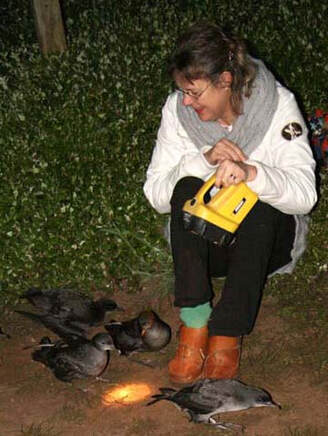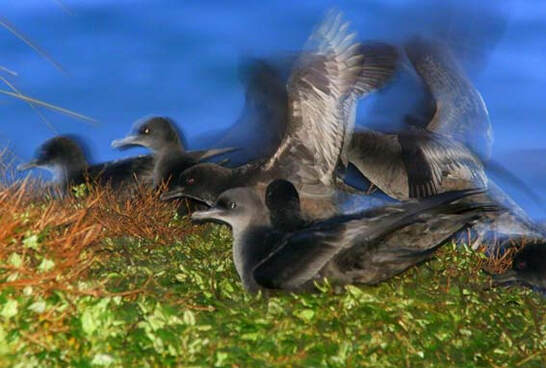 Photos by Terry Melvin
Photos by Terry Melvin When Laura Brearley went for a walk to see the shearwaters return at dusk, she had no idea it would change her life and lead to Phillip Island’s first Shearwater Festival.
By Laura Brearley
IT WAS a cold night three years ago at Cape Woolamai that I first came across the shearwaters. I had heard that the shearwaters were back from Alaska and that they came in to shore at dusk. The locals had many stories about the birds and for the most part, it seemed, held a deep affection for them.
I was working as an associate professor in the faculty of education at Monash Gippsland, where my husband also worked. We led absurdly busy lives. We were living on a bush property in the Strzelecki Ranges near the university. I was still recovering from the intensity of the Black Saturday bushfires and had a deep longing, a need actually, to be near the ocean.
By Laura Brearley
IT WAS a cold night three years ago at Cape Woolamai that I first came across the shearwaters. I had heard that the shearwaters were back from Alaska and that they came in to shore at dusk. The locals had many stories about the birds and for the most part, it seemed, held a deep affection for them.
I was working as an associate professor in the faculty of education at Monash Gippsland, where my husband also worked. We led absurdly busy lives. We were living on a bush property in the Strzelecki Ranges near the university. I was still recovering from the intensity of the Black Saturday bushfires and had a deep longing, a need actually, to be near the ocean.
At dusk, one night in September 2009, I took a walk along the cliff tops of Cape Woolamai, hoping to see the shearwaters. Ahead, I could see a group of people gathered, waiting for the birds to return from their day at sea. I began talking with them and learned that they were members of the Victorian Ornithological Research Group. They loved birds and were deeply informed. They were generous with their knowledge. They were there that night to find out whether the birds returned to the same burrows they had previously lived in.
The parent shearwaters forage hundreds of kilometres from the
nest for food for their chicks.
We stood there together as the sun slowly set and then watched as the sky filled with thousands of wide-winged birds, whooshing through the air and landing on the ground around us. It wasn’t until after they had landed that they began their distinctive cackling sounds that fell somewhere between a laugh and a snort, low pitched, high pitched and then back again. The ground sounded alive.
The bird enthusiasts told me the pre-dawn experience was equally awe-inspiring. I set the alarm for four o’clock, rugged up warmly and walked by torch light along the beach and then up the Magic Lands steps to the rookeries. I could see a couple of torches ahead of me and as I drew closer saw that two of the VORG members were already there.
It was a slow build-up but gradually the night air filled with the sounds of the shearwaters waking. There was a sense of theatre about it. The ground began to turn black with birds as they made their way to the edge of the cliffs for take-off. The bird numbers swelled as the light of the dawn filled the sky and then suddenly they were all gone. “Not many people have seen what you’ve just witnessed,” one of the VORG members said to me.
I knew I had seen something extraordinary and it filled me with joy. I went back to my busy life as an academic, but something in me had changed. My husband and I began to talk about a gentler life with a slower pace. We bought property at Cape Woolamai backing on to the coastal reserve. We decided to leave our jobs and set up a beach retreat, Woolamai Beach Hideaway. We are surrounded by shearwater rookeries. We hear the birds coming back at night and hear their calls in the early hours of the morning.
Some one million short-tailed shearwaters make the migration to
the Phillip Island coastline each year, flying about 15,000 kilometres
from the Bering Sea near Alaska in September and October. The parents
make the return journey in April. The chicks set off several weeks later.
I love them. I love their courage in flying inconceivably long distances across the oceans. I love their grace in flight and the way they glide with the wind. I love the way they link us to the traditional owners of this beautiful country and to the people in the Northern Hemisphere.
When I first came across them, I had no idea that my life would become intertwined with theirs. Vincent Serventy also loved the birds and spent a life-time researching them. In his 1996 book Flight of the Shearwater, he writes, “The birds are like a living wind that blows around the world. Forever we have the spirit of the shearwaters interwoven with our own.”
The parent shearwaters forage hundreds of kilometres from the
nest for food for their chicks.
We stood there together as the sun slowly set and then watched as the sky filled with thousands of wide-winged birds, whooshing through the air and landing on the ground around us. It wasn’t until after they had landed that they began their distinctive cackling sounds that fell somewhere between a laugh and a snort, low pitched, high pitched and then back again. The ground sounded alive.
The bird enthusiasts told me the pre-dawn experience was equally awe-inspiring. I set the alarm for four o’clock, rugged up warmly and walked by torch light along the beach and then up the Magic Lands steps to the rookeries. I could see a couple of torches ahead of me and as I drew closer saw that two of the VORG members were already there.
It was a slow build-up but gradually the night air filled with the sounds of the shearwaters waking. There was a sense of theatre about it. The ground began to turn black with birds as they made their way to the edge of the cliffs for take-off. The bird numbers swelled as the light of the dawn filled the sky and then suddenly they were all gone. “Not many people have seen what you’ve just witnessed,” one of the VORG members said to me.
I knew I had seen something extraordinary and it filled me with joy. I went back to my busy life as an academic, but something in me had changed. My husband and I began to talk about a gentler life with a slower pace. We bought property at Cape Woolamai backing on to the coastal reserve. We decided to leave our jobs and set up a beach retreat, Woolamai Beach Hideaway. We are surrounded by shearwater rookeries. We hear the birds coming back at night and hear their calls in the early hours of the morning.
Some one million short-tailed shearwaters make the migration to
the Phillip Island coastline each year, flying about 15,000 kilometres
from the Bering Sea near Alaska in September and October. The parents
make the return journey in April. The chicks set off several weeks later.
I love them. I love their courage in flying inconceivably long distances across the oceans. I love their grace in flight and the way they glide with the wind. I love the way they link us to the traditional owners of this beautiful country and to the people in the Northern Hemisphere.
When I first came across them, I had no idea that my life would become intertwined with theirs. Vincent Serventy also loved the birds and spent a life-time researching them. In his 1996 book Flight of the Shearwater, he writes, “The birds are like a living wind that blows around the world. Forever we have the spirit of the shearwaters interwoven with our own.”
I didn’t know it three years ago when I took that walk along the cliffs at Cape Woolamai but the spirit of the birds has indeed become interwoven with my own. I am now working with many wonderful people in the local community who also love the birds and who are helping to bring the Shearwater Festival to life.
On November 24 and 25, we will be hosting the inaugural festival on Phillip Island to celebrate the short-tailed shearwater birds. Shearwater Festival: Celebrating Biyadin is designed to bring the community together to promote cross-cultural understanding and environmental awareness, with a focus on the shearwaters as symbols of the cycle of life and global interconnectedness.
A partnership involving Bass Coast Shire Council, Phillip Island Nature Parks, the Victorian Aboriginal Corporation of Languages, local schools, businesses and community organisations, the weekend will include art displays, concerts, environmental talks and guided walks at dawn and dusk to see the shearwaters taking off and returning to the rookeries at Cape Woolamai.
Biyadin is the local Boonwurrung/Bunurong word for the shearwaters,
also known as mutton bids, moon birds and yolla.
On the Saturday, there is an official opening and talks about the shearwaters. The art exhibition will be launched in the afternoon and there is a Biyadin Concert at the Nobbies. There are guided walks to see the shearwaters at Cape Woolamai at dusk on Saturday and before dawn on Sunday.
Sunday is Deep Listening Day at the Nobbies Centre. It includes Deep Listening Circles led by Australian and Canadian Indigenous leaders and an international message exchange between children and artists on the shearwater flight path.
Artists, photographers, poets, musicians and dancers are submitting and presenting artworks, photographs, poems and songs that celebrate the shearwaters, the beauty of the local environment they live in and the global interconnectedness they represent.
The festival has tapped into the creativity of the local community and the shared appreciation of the beautiful birds. Co-ordinating the festival has been a wonderful way to come to know the community and to share this sense of interconnectedness.
On November 24 and 25, we will be hosting the inaugural festival on Phillip Island to celebrate the short-tailed shearwater birds. Shearwater Festival: Celebrating Biyadin is designed to bring the community together to promote cross-cultural understanding and environmental awareness, with a focus on the shearwaters as symbols of the cycle of life and global interconnectedness.
A partnership involving Bass Coast Shire Council, Phillip Island Nature Parks, the Victorian Aboriginal Corporation of Languages, local schools, businesses and community organisations, the weekend will include art displays, concerts, environmental talks and guided walks at dawn and dusk to see the shearwaters taking off and returning to the rookeries at Cape Woolamai.
Biyadin is the local Boonwurrung/Bunurong word for the shearwaters,
also known as mutton bids, moon birds and yolla.
On the Saturday, there is an official opening and talks about the shearwaters. The art exhibition will be launched in the afternoon and there is a Biyadin Concert at the Nobbies. There are guided walks to see the shearwaters at Cape Woolamai at dusk on Saturday and before dawn on Sunday.
Sunday is Deep Listening Day at the Nobbies Centre. It includes Deep Listening Circles led by Australian and Canadian Indigenous leaders and an international message exchange between children and artists on the shearwater flight path.
Artists, photographers, poets, musicians and dancers are submitting and presenting artworks, photographs, poems and songs that celebrate the shearwaters, the beauty of the local environment they live in and the global interconnectedness they represent.
The festival has tapped into the creativity of the local community and the shared appreciation of the beautiful birds. Co-ordinating the festival has been a wonderful way to come to know the community and to share this sense of interconnectedness.
